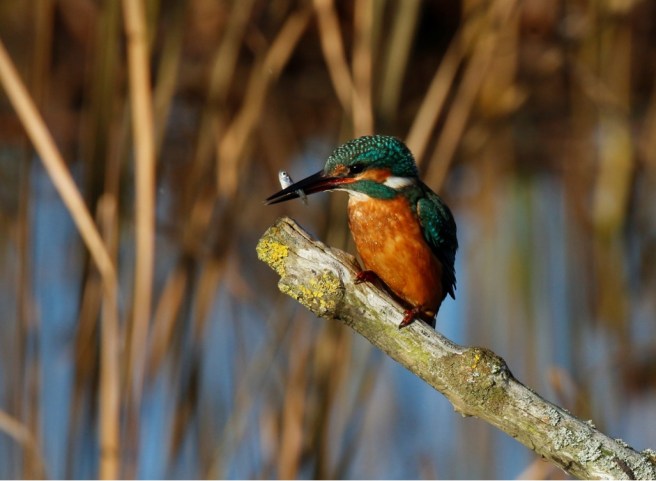An Archaeologist has come to visit the meadows

In 55BC, Julius Caesar sailed over to Britain with a fleet of 80 ships. He arrived off Dover but didn’t like being overlooked by hostile tribesmen on the cliffs and so came around the corner towards Deal. However, the Britons tracked him by riding their chariots along the cliffs, including through our meadows which paints a captivating image in my mind. Where he finally decided to land has not been established to the satisfaction of all and there is an argument for saying that it was in the wet meadow alongside Walmer Castle, which may have been more of an inlet back then.

The Britons put up a fight to try to stop the Romans landing but were eventually defeated and forced inland. Caesar would have set up some sort of camp nearby to protect his shipping because he didn’t intend to stay long and would have been trapped here if his ships had been damaged.
He returned again the next year, 54BC, this time with 800 ships, landing along the shoreline a bit to the north of here and stayed for a couple of months. Nearly 100 years later, in 43AD, the Romans led by Claudius landed for a third time and stayed for four centuries.
But it is that very first landing in 55BC that potentially has significance for these meadows. If it was indeed near here, then there may be evidence to be found.
We haven’t done any metal detecting this winter yet because we really should be coppicing in the wood if we have spare time like that. However, from now on, we will be on the look out for lead Roman slingshot which is quite distinctive:

The Archaeologist who visited us last week hopes to return next year to do some geophysical work to look for ditches or other evidence of the potential 55BC Roman encampment.
There was a big collection of these larvae under one of the reptile sampling squares a few days ago. Pretty amazing that this would be happening in December, surely? And what on earth are they?


They were completely earth-coloured. They also don’t seem to have legs and so I am thinking that they are probably more at the fly end of things rather than the butterfly or moth end. However, more than that, I really don’t know, although I would love to. If they were butterfly or moth caterpillars, there are books to refer to or people I could ask but information is much less available for flies and other insects. I suppose I could have taken a couple of the larvae away to try to hatch them out in a tank but my chance of success has to be small with so little understanding of what they are and what they need.
I will keep these photos handy should I ever chance upon an entomologist.
There was also this Smooth Newt under one of the Reptile sampling squares:


All of our native Amphibians don’t actually hibernate through the winter but tuck themselves away somewhere frost-free and come out to forage when it is mild. This Smooth Newt is nocturnal and will be out and about looking for Earthworms, Slugs and other insects on the winter nights that are not too cold.
We continue to put peanuts on this stoney pinnacle at dusk:

I suppose what I am really hoping for is to see a Badger getting itself up there, but that is a long way from happening. However, the Foxes indulge me every night:





In recent days there has been only one sighting of the Heron:

Again, it seemed very discombobulated by the anti-Heron string that we have set up around the pond. But we frequently have to repair these strings because they are chewed. We knew it was the Foxes doing this but only now do we have the evidence to convict:

There is now a small-mesh and a large-mesh cage up on the strip to preserve some of the seed for small farmland birds:

However, it appears that the large mesh is mostly not safe from Crows:

Unfortunately there was dew on the lens but the ringed Kestrel has also been up to see what all the fuss is about:

There have been many days recently that can by summed up by this trail camera photo, where the sky is darker than the sea:

The weather has not been suitable for bird ringing, but we have been busy making a ‘lobster pot’ bird catcher to the bird ringer’s design:

The idea is to put seed down on the ground to get the birds used to the idea of that and then putting this cage down over the seed and hoping that they will go in but not be able to work out how to get out. Obviously the cage will be closely observed while it is down and any bird that is caught like this can be ringed and released.
Also, from the meadows:




Over in the wood, there is a darker Pheasant that I don’t understand:



Is this a juvenile male? Actually, I realise that there is much about Pheasants that I don’t understand. I presumed that we were going to see smaller, juvenile Pheasants over the summer but I don’t think we did. I will ask the bird ringer what’s going when I next see him.
Also in the wood:




The bird ringer may not have been able to ring in the meadows recently but I finish today with some fantastic photos he took from a hide on a nearby reserve on the River Stour and has allowed me to include here:



What a fantastic bird, although we could never hope to see a Kingfisher in either the meadows or the wood.
